HI6028 Taxation Law: Partnership Income and Fringe Benefits T3 2018
VerifiedAdded on 2023/04/21
|13
|2244
|339
Homework Assignment
AI Summary
This assignment provides solutions to taxation law problems concerning partnership income and fringe benefits. It analyzes the calculation of partnership net income, considering ordinary income concepts, allowable deductions under the Income Tax Assessment Act 1997, and relevant case law. The assignment further examines the tax consequences of fringe benefits provided to an employee, focusing on expense payment fringe benefits and housing fringe benefits, referencing the FBT Assessment Act 1986. The solutions demonstrate the application of relevant legislative provisions to determine taxable values and employer tax liabilities.
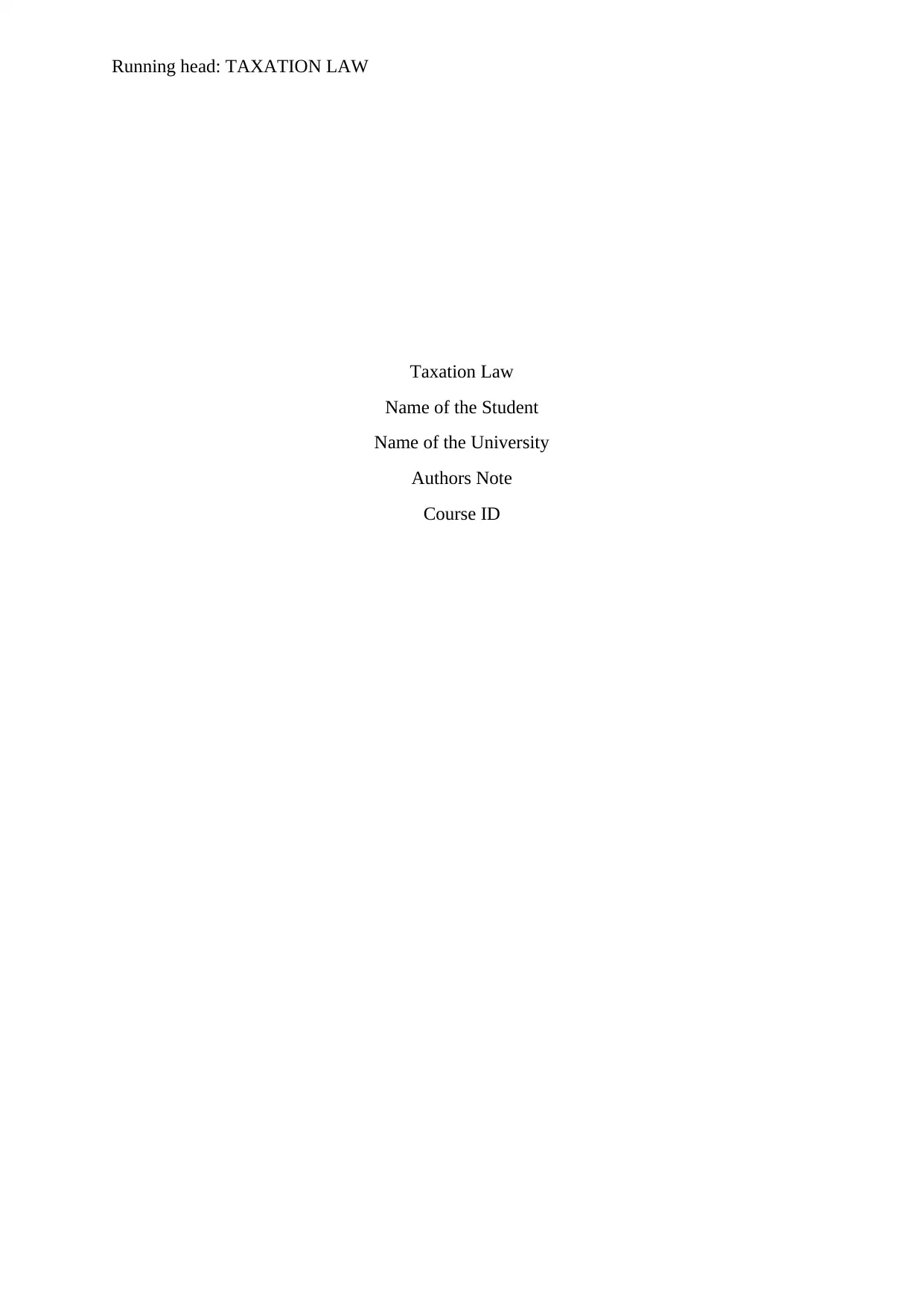
Running head: TAXATION LAW
Taxation Law
Name of the Student
Name of the University
Authors Note
Course ID
Taxation Law
Name of the Student
Name of the University
Authors Note
Course ID
Paraphrase This Document
Need a fresh take? Get an instant paraphrase of this document with our AI Paraphraser
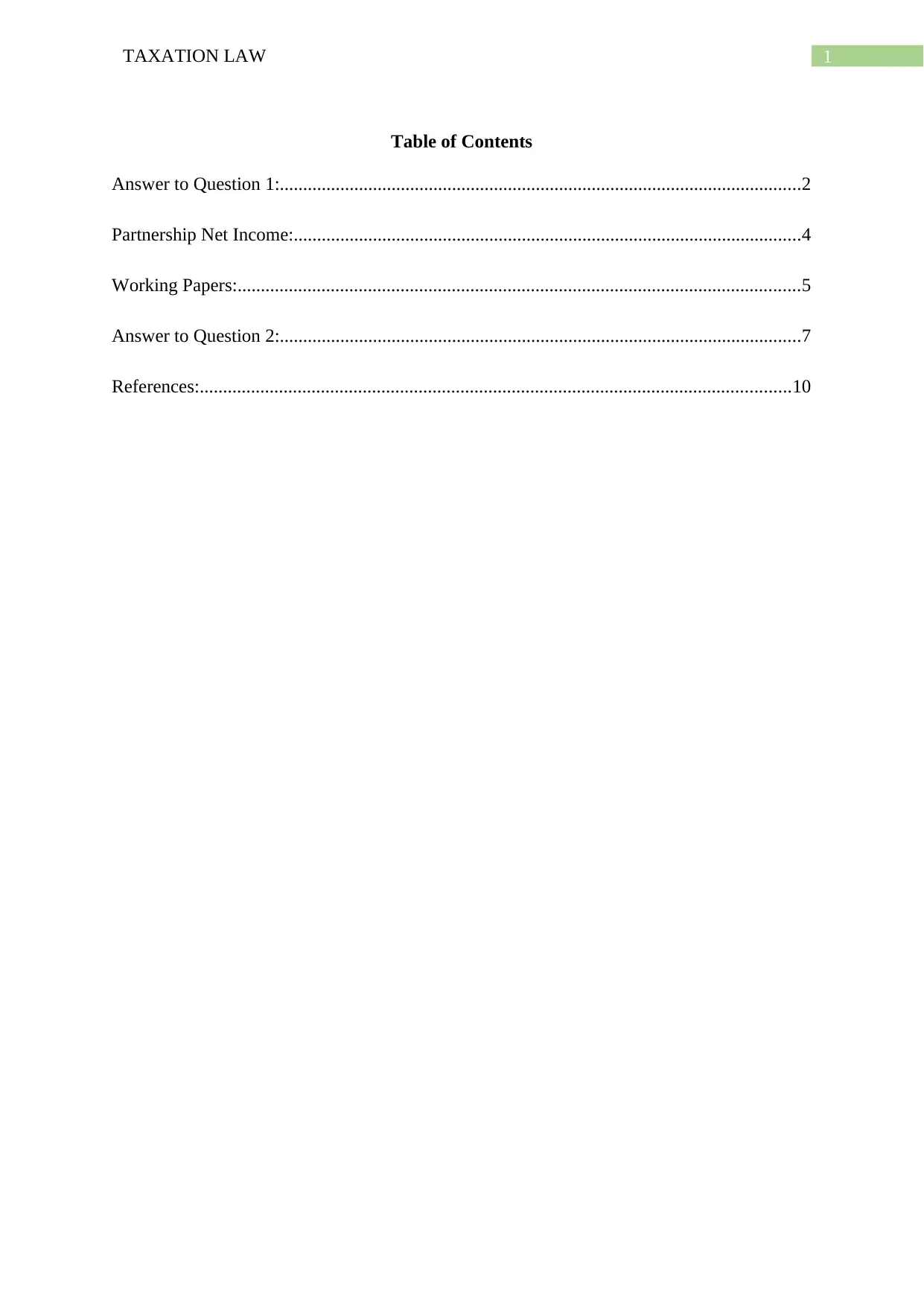
1TAXATION LAW
Table of Contents
Answer to Question 1:................................................................................................................2
Partnership Net Income:.............................................................................................................4
Working Papers:.........................................................................................................................5
Answer to Question 2:................................................................................................................7
References:...............................................................................................................................10
Table of Contents
Answer to Question 1:................................................................................................................2
Partnership Net Income:.............................................................................................................4
Working Papers:.........................................................................................................................5
Answer to Question 2:................................................................................................................7
References:...............................................................................................................................10
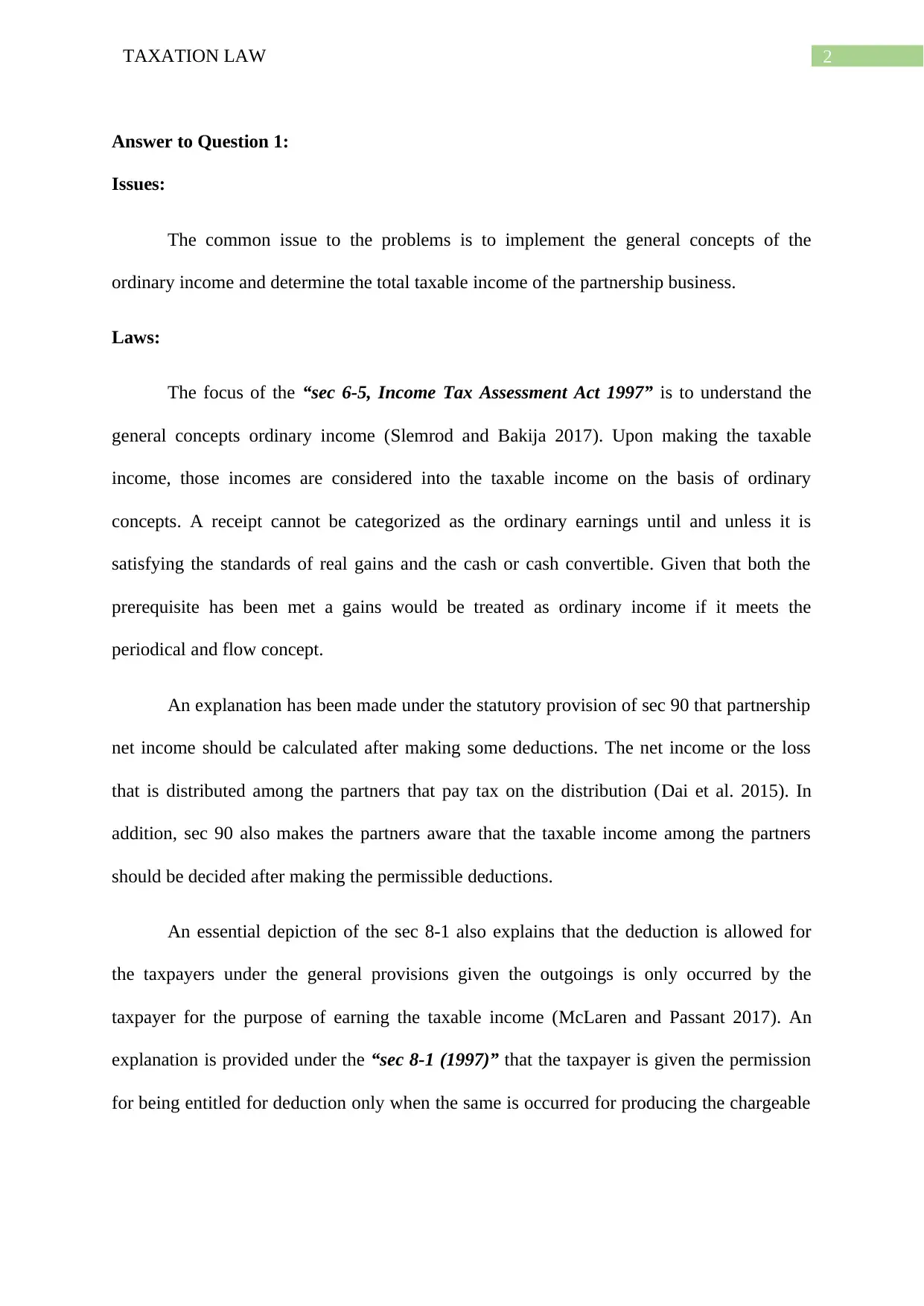
2TAXATION LAW
Answer to Question 1:
Issues:
The common issue to the problems is to implement the general concepts of the
ordinary income and determine the total taxable income of the partnership business.
Laws:
The focus of the “sec 6-5, Income Tax Assessment Act 1997” is to understand the
general concepts ordinary income (Slemrod and Bakija 2017). Upon making the taxable
income, those incomes are considered into the taxable income on the basis of ordinary
concepts. A receipt cannot be categorized as the ordinary earnings until and unless it is
satisfying the standards of real gains and the cash or cash convertible. Given that both the
prerequisite has been met a gains would be treated as ordinary income if it meets the
periodical and flow concept.
An explanation has been made under the statutory provision of sec 90 that partnership
net income should be calculated after making some deductions. The net income or the loss
that is distributed among the partners that pay tax on the distribution (Dai et al. 2015). In
addition, sec 90 also makes the partners aware that the taxable income among the partners
should be decided after making the permissible deductions.
An essential depiction of the sec 8-1 also explains that the deduction is allowed for
the taxpayers under the general provisions given the outgoings is only occurred by the
taxpayer for the purpose of earning the taxable income (McLaren and Passant 2017). An
explanation is provided under the “sec 8-1 (1997)” that the taxpayer is given the permission
for being entitled for deduction only when the same is occurred for producing the chargeable
Answer to Question 1:
Issues:
The common issue to the problems is to implement the general concepts of the
ordinary income and determine the total taxable income of the partnership business.
Laws:
The focus of the “sec 6-5, Income Tax Assessment Act 1997” is to understand the
general concepts ordinary income (Slemrod and Bakija 2017). Upon making the taxable
income, those incomes are considered into the taxable income on the basis of ordinary
concepts. A receipt cannot be categorized as the ordinary earnings until and unless it is
satisfying the standards of real gains and the cash or cash convertible. Given that both the
prerequisite has been met a gains would be treated as ordinary income if it meets the
periodical and flow concept.
An explanation has been made under the statutory provision of sec 90 that partnership
net income should be calculated after making some deductions. The net income or the loss
that is distributed among the partners that pay tax on the distribution (Dai et al. 2015). In
addition, sec 90 also makes the partners aware that the taxable income among the partners
should be decided after making the permissible deductions.
An essential depiction of the sec 8-1 also explains that the deduction is allowed for
the taxpayers under the general provisions given the outgoings is only occurred by the
taxpayer for the purpose of earning the taxable income (McLaren and Passant 2017). An
explanation is provided under the “sec 8-1 (1997)” that the taxpayer is given the permission
for being entitled for deduction only when the same is occurred for producing the chargeable
⊘ This is a preview!⊘
Do you want full access?
Subscribe today to unlock all pages.

Trusted by 1+ million students worldwide
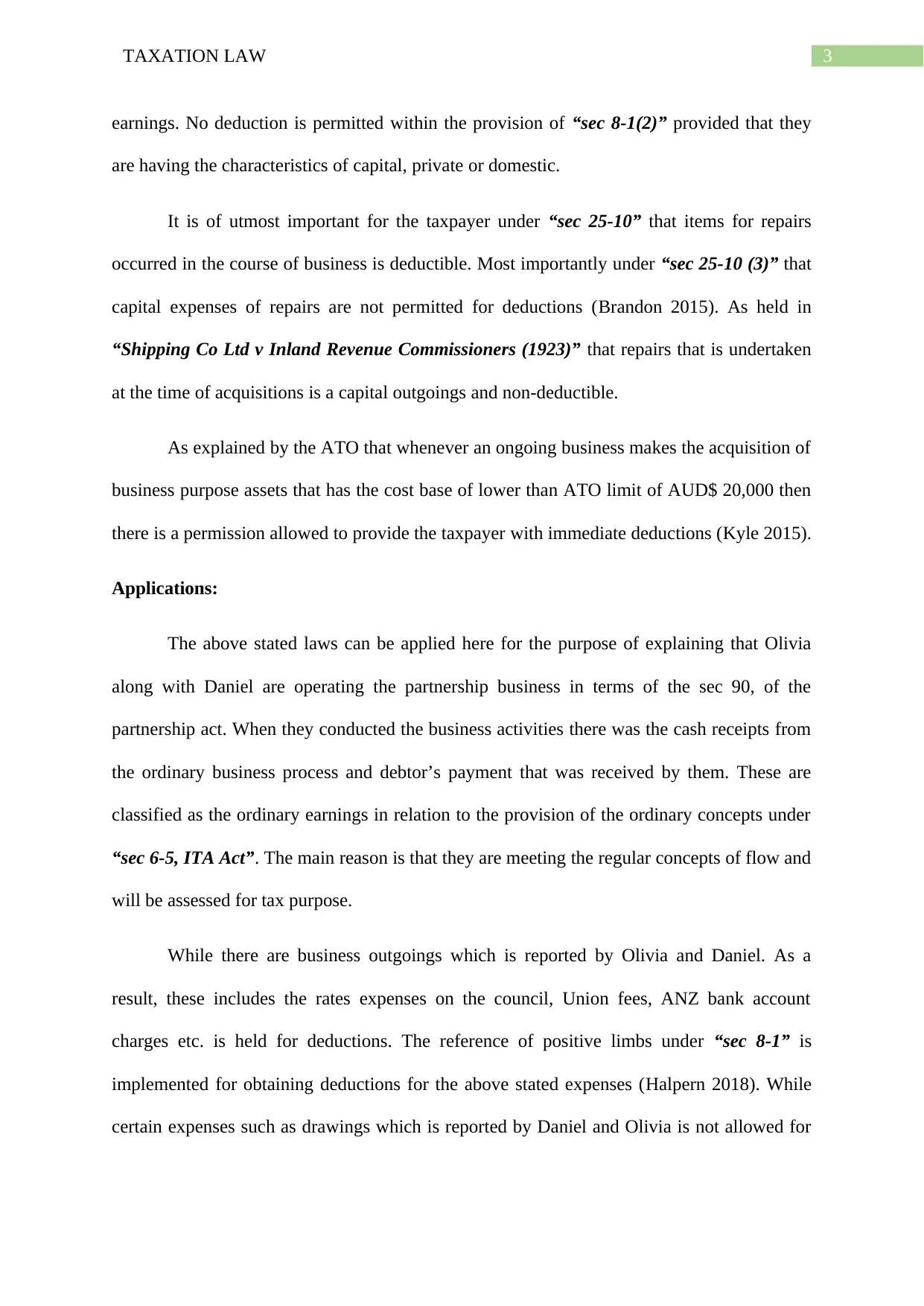
3TAXATION LAW
earnings. No deduction is permitted within the provision of “sec 8-1(2)” provided that they
are having the characteristics of capital, private or domestic.
It is of utmost important for the taxpayer under “sec 25-10” that items for repairs
occurred in the course of business is deductible. Most importantly under “sec 25-10 (3)” that
capital expenses of repairs are not permitted for deductions (Brandon 2015). As held in
“Shipping Co Ltd v Inland Revenue Commissioners (1923)” that repairs that is undertaken
at the time of acquisitions is a capital outgoings and non-deductible.
As explained by the ATO that whenever an ongoing business makes the acquisition of
business purpose assets that has the cost base of lower than ATO limit of AUD$ 20,000 then
there is a permission allowed to provide the taxpayer with immediate deductions (Kyle 2015).
Applications:
The above stated laws can be applied here for the purpose of explaining that Olivia
along with Daniel are operating the partnership business in terms of the sec 90, of the
partnership act. When they conducted the business activities there was the cash receipts from
the ordinary business process and debtor’s payment that was received by them. These are
classified as the ordinary earnings in relation to the provision of the ordinary concepts under
“sec 6-5, ITA Act”. The main reason is that they are meeting the regular concepts of flow and
will be assessed for tax purpose.
While there are business outgoings which is reported by Olivia and Daniel. As a
result, these includes the rates expenses on the council, Union fees, ANZ bank account
charges etc. is held for deductions. The reference of positive limbs under “sec 8-1” is
implemented for obtaining deductions for the above stated expenses (Halpern 2018). While
certain expenses such as drawings which is reported by Daniel and Olivia is not allowed for
earnings. No deduction is permitted within the provision of “sec 8-1(2)” provided that they
are having the characteristics of capital, private or domestic.
It is of utmost important for the taxpayer under “sec 25-10” that items for repairs
occurred in the course of business is deductible. Most importantly under “sec 25-10 (3)” that
capital expenses of repairs are not permitted for deductions (Brandon 2015). As held in
“Shipping Co Ltd v Inland Revenue Commissioners (1923)” that repairs that is undertaken
at the time of acquisitions is a capital outgoings and non-deductible.
As explained by the ATO that whenever an ongoing business makes the acquisition of
business purpose assets that has the cost base of lower than ATO limit of AUD$ 20,000 then
there is a permission allowed to provide the taxpayer with immediate deductions (Kyle 2015).
Applications:
The above stated laws can be applied here for the purpose of explaining that Olivia
along with Daniel are operating the partnership business in terms of the sec 90, of the
partnership act. When they conducted the business activities there was the cash receipts from
the ordinary business process and debtor’s payment that was received by them. These are
classified as the ordinary earnings in relation to the provision of the ordinary concepts under
“sec 6-5, ITA Act”. The main reason is that they are meeting the regular concepts of flow and
will be assessed for tax purpose.
While there are business outgoings which is reported by Olivia and Daniel. As a
result, these includes the rates expenses on the council, Union fees, ANZ bank account
charges etc. is held for deductions. The reference of positive limbs under “sec 8-1” is
implemented for obtaining deductions for the above stated expenses (Halpern 2018). While
certain expenses such as drawings which is reported by Daniel and Olivia is not allowed for
Paraphrase This Document
Need a fresh take? Get an instant paraphrase of this document with our AI Paraphraser
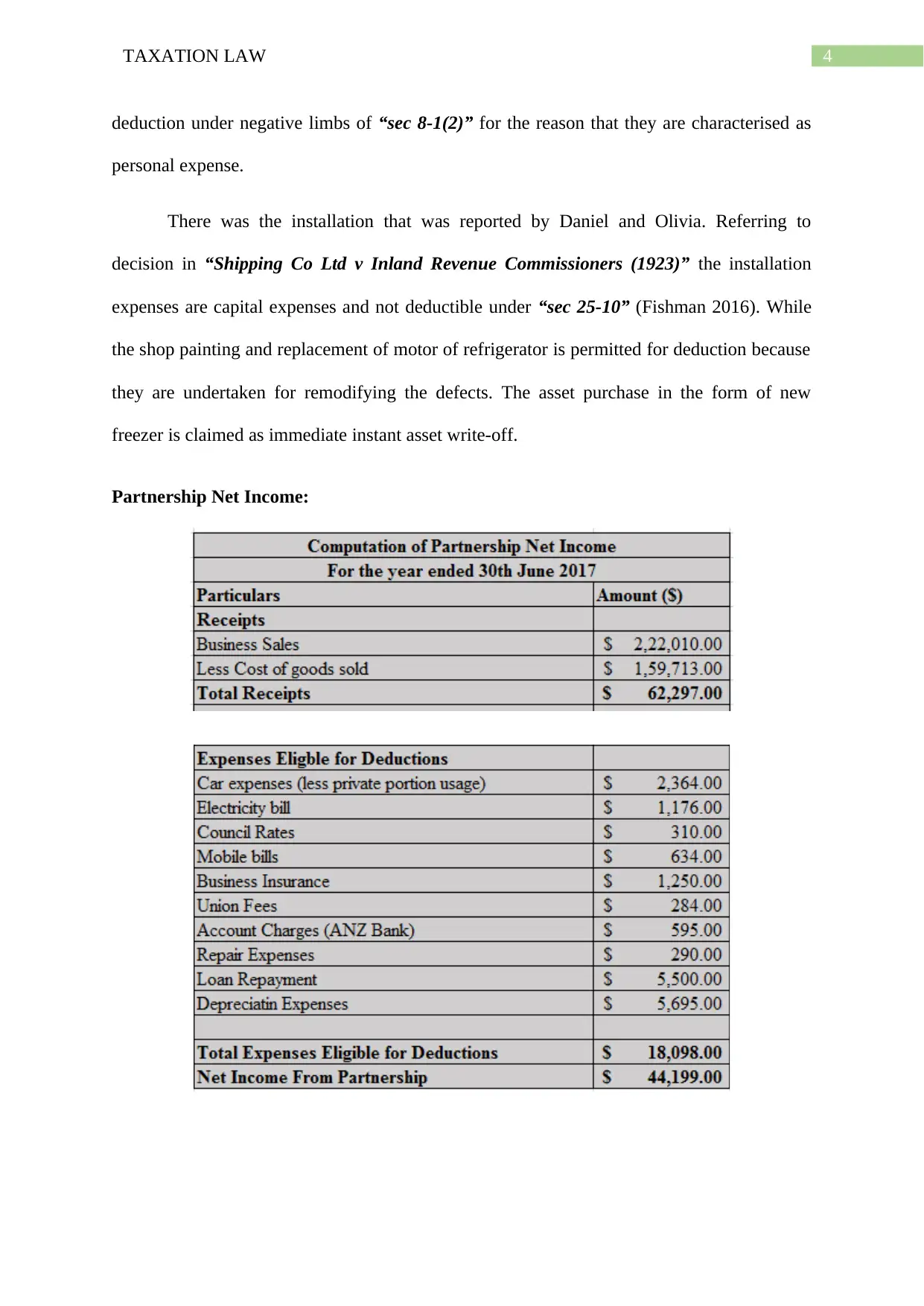
4TAXATION LAW
deduction under negative limbs of “sec 8-1(2)” for the reason that they are characterised as
personal expense.
There was the installation that was reported by Daniel and Olivia. Referring to
decision in “Shipping Co Ltd v Inland Revenue Commissioners (1923)” the installation
expenses are capital expenses and not deductible under “sec 25-10” (Fishman 2016). While
the shop painting and replacement of motor of refrigerator is permitted for deduction because
they are undertaken for remodifying the defects. The asset purchase in the form of new
freezer is claimed as immediate instant asset write-off.
Partnership Net Income:
deduction under negative limbs of “sec 8-1(2)” for the reason that they are characterised as
personal expense.
There was the installation that was reported by Daniel and Olivia. Referring to
decision in “Shipping Co Ltd v Inland Revenue Commissioners (1923)” the installation
expenses are capital expenses and not deductible under “sec 25-10” (Fishman 2016). While
the shop painting and replacement of motor of refrigerator is permitted for deduction because
they are undertaken for remodifying the defects. The asset purchase in the form of new
freezer is claimed as immediate instant asset write-off.
Partnership Net Income:
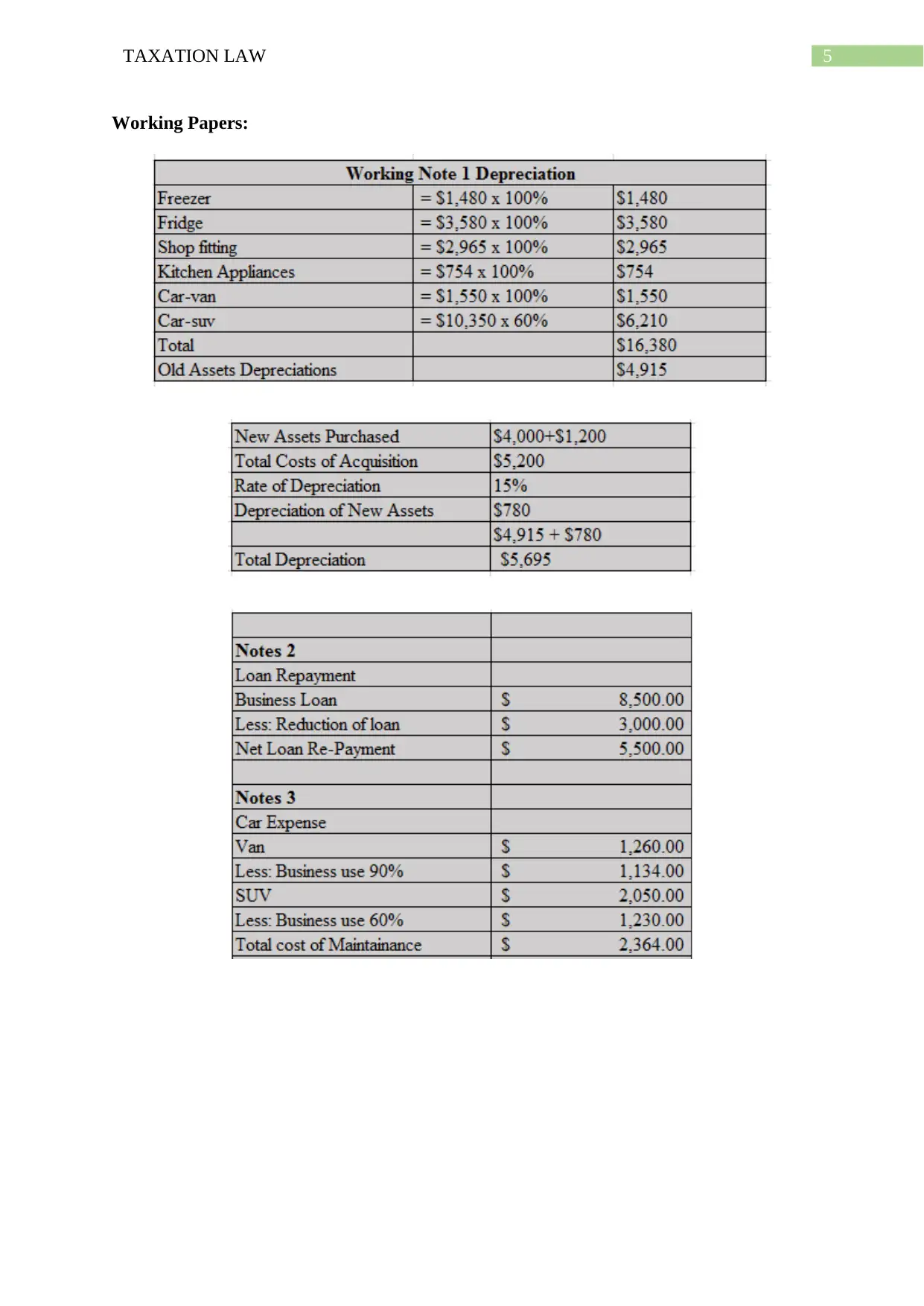
5TAXATION LAW
Working Papers:
Working Papers:
⊘ This is a preview!⊘
Do you want full access?
Subscribe today to unlock all pages.

Trusted by 1+ million students worldwide
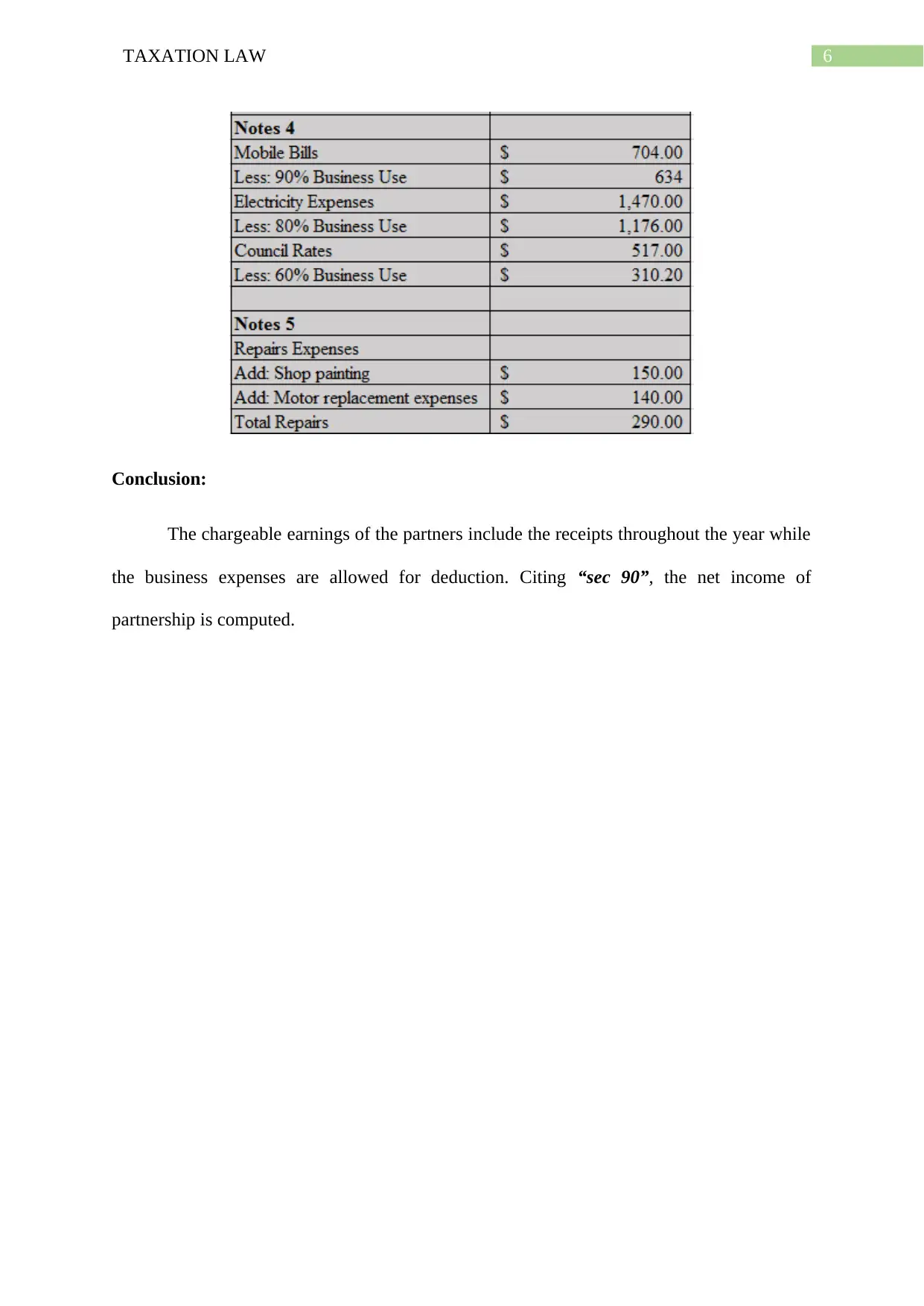
6TAXATION LAW
Conclusion:
The chargeable earnings of the partners include the receipts throughout the year while
the business expenses are allowed for deduction. Citing “sec 90”, the net income of
partnership is computed.
Conclusion:
The chargeable earnings of the partners include the receipts throughout the year while
the business expenses are allowed for deduction. Citing “sec 90”, the net income of
partnership is computed.
Paraphrase This Document
Need a fresh take? Get an instant paraphrase of this document with our AI Paraphraser
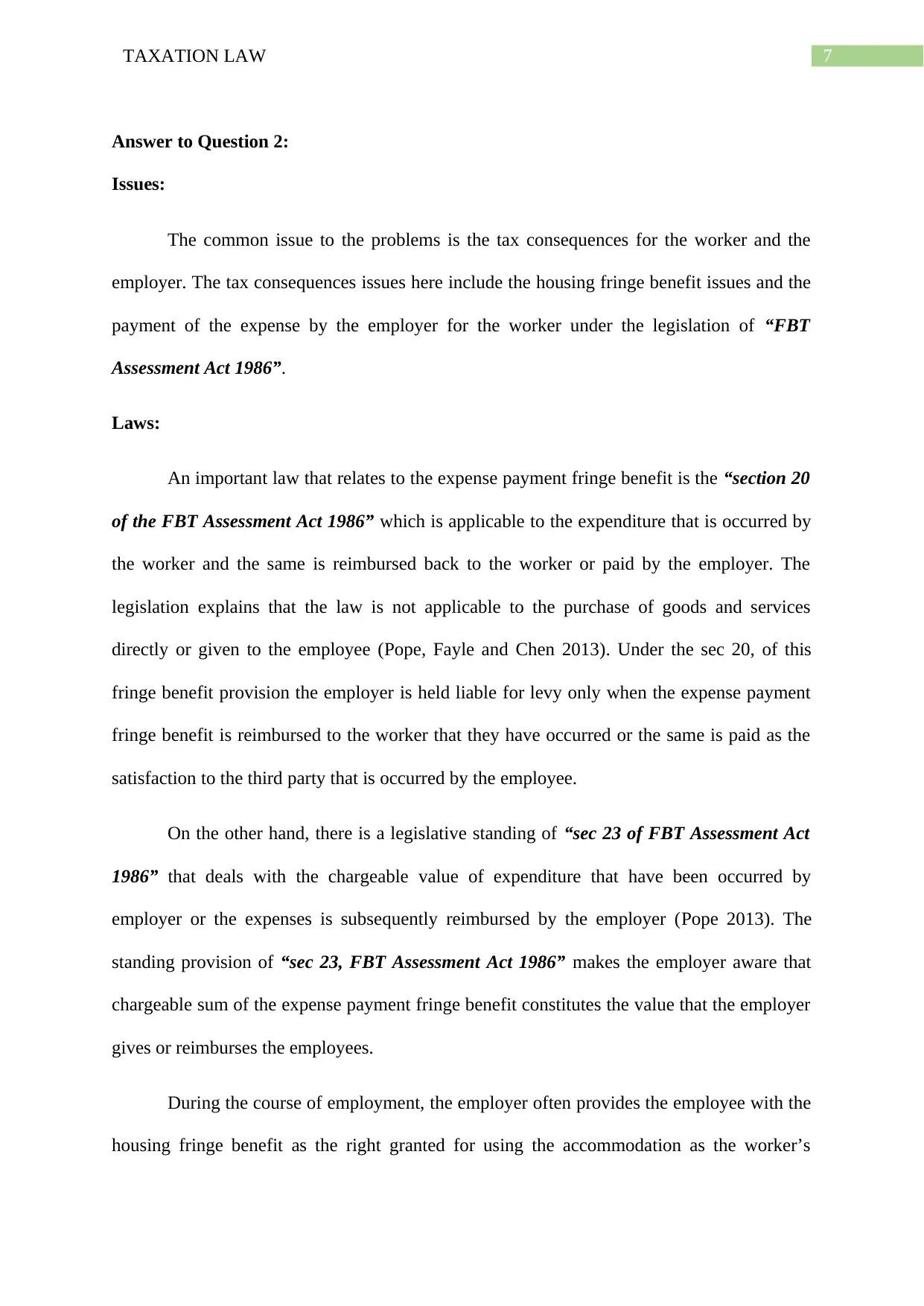
7TAXATION LAW
Answer to Question 2:
Issues:
The common issue to the problems is the tax consequences for the worker and the
employer. The tax consequences issues here include the housing fringe benefit issues and the
payment of the expense by the employer for the worker under the legislation of “FBT
Assessment Act 1986”.
Laws:
An important law that relates to the expense payment fringe benefit is the “section 20
of the FBT Assessment Act 1986” which is applicable to the expenditure that is occurred by
the worker and the same is reimbursed back to the worker or paid by the employer. The
legislation explains that the law is not applicable to the purchase of goods and services
directly or given to the employee (Pope, Fayle and Chen 2013). Under the sec 20, of this
fringe benefit provision the employer is held liable for levy only when the expense payment
fringe benefit is reimbursed to the worker that they have occurred or the same is paid as the
satisfaction to the third party that is occurred by the employee.
On the other hand, there is a legislative standing of “sec 23 of FBT Assessment Act
1986” that deals with the chargeable value of expenditure that have been occurred by
employer or the expenses is subsequently reimbursed by the employer (Pope 2013). The
standing provision of “sec 23, FBT Assessment Act 1986” makes the employer aware that
chargeable sum of the expense payment fringe benefit constitutes the value that the employer
gives or reimburses the employees.
During the course of employment, the employer often provides the employee with the
housing fringe benefit as the right granted for using the accommodation as the worker’s
Answer to Question 2:
Issues:
The common issue to the problems is the tax consequences for the worker and the
employer. The tax consequences issues here include the housing fringe benefit issues and the
payment of the expense by the employer for the worker under the legislation of “FBT
Assessment Act 1986”.
Laws:
An important law that relates to the expense payment fringe benefit is the “section 20
of the FBT Assessment Act 1986” which is applicable to the expenditure that is occurred by
the worker and the same is reimbursed back to the worker or paid by the employer. The
legislation explains that the law is not applicable to the purchase of goods and services
directly or given to the employee (Pope, Fayle and Chen 2013). Under the sec 20, of this
fringe benefit provision the employer is held liable for levy only when the expense payment
fringe benefit is reimbursed to the worker that they have occurred or the same is paid as the
satisfaction to the third party that is occurred by the employee.
On the other hand, there is a legislative standing of “sec 23 of FBT Assessment Act
1986” that deals with the chargeable value of expenditure that have been occurred by
employer or the expenses is subsequently reimbursed by the employer (Pope 2013). The
standing provision of “sec 23, FBT Assessment Act 1986” makes the employer aware that
chargeable sum of the expense payment fringe benefit constitutes the value that the employer
gives or reimburses the employees.
During the course of employment, the employer often provides the employee with the
housing fringe benefit as the right granted for using the accommodation as the worker’s
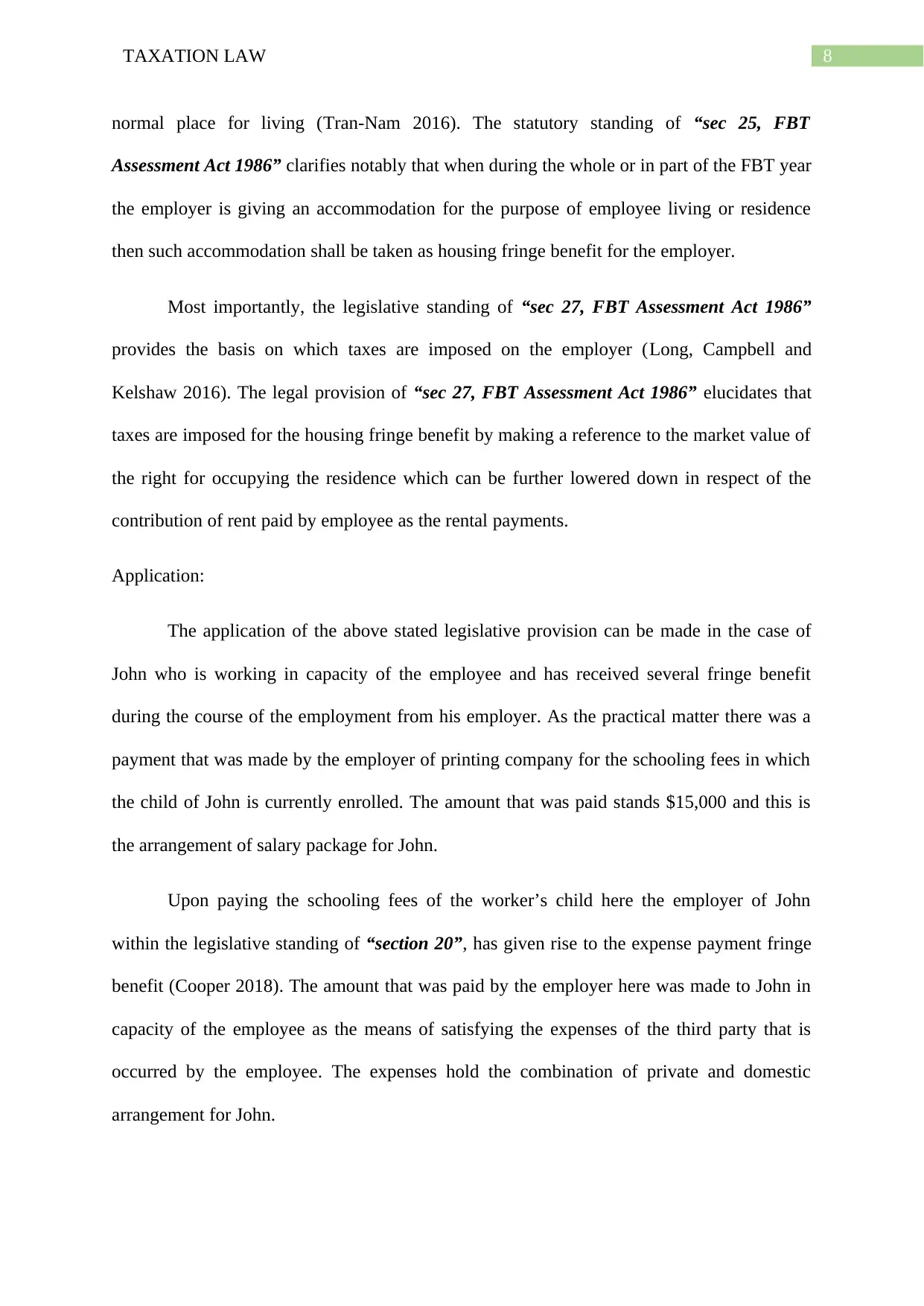
8TAXATION LAW
normal place for living (Tran-Nam 2016). The statutory standing of “sec 25, FBT
Assessment Act 1986” clarifies notably that when during the whole or in part of the FBT year
the employer is giving an accommodation for the purpose of employee living or residence
then such accommodation shall be taken as housing fringe benefit for the employer.
Most importantly, the legislative standing of “sec 27, FBT Assessment Act 1986”
provides the basis on which taxes are imposed on the employer (Long, Campbell and
Kelshaw 2016). The legal provision of “sec 27, FBT Assessment Act 1986” elucidates that
taxes are imposed for the housing fringe benefit by making a reference to the market value of
the right for occupying the residence which can be further lowered down in respect of the
contribution of rent paid by employee as the rental payments.
Application:
The application of the above stated legislative provision can be made in the case of
John who is working in capacity of the employee and has received several fringe benefit
during the course of the employment from his employer. As the practical matter there was a
payment that was made by the employer of printing company for the schooling fees in which
the child of John is currently enrolled. The amount that was paid stands $15,000 and this is
the arrangement of salary package for John.
Upon paying the schooling fees of the worker’s child here the employer of John
within the legislative standing of “section 20”, has given rise to the expense payment fringe
benefit (Cooper 2018). The amount that was paid by the employer here was made to John in
capacity of the employee as the means of satisfying the expenses of the third party that is
occurred by the employee. The expenses hold the combination of private and domestic
arrangement for John.
normal place for living (Tran-Nam 2016). The statutory standing of “sec 25, FBT
Assessment Act 1986” clarifies notably that when during the whole or in part of the FBT year
the employer is giving an accommodation for the purpose of employee living or residence
then such accommodation shall be taken as housing fringe benefit for the employer.
Most importantly, the legislative standing of “sec 27, FBT Assessment Act 1986”
provides the basis on which taxes are imposed on the employer (Long, Campbell and
Kelshaw 2016). The legal provision of “sec 27, FBT Assessment Act 1986” elucidates that
taxes are imposed for the housing fringe benefit by making a reference to the market value of
the right for occupying the residence which can be further lowered down in respect of the
contribution of rent paid by employee as the rental payments.
Application:
The application of the above stated legislative provision can be made in the case of
John who is working in capacity of the employee and has received several fringe benefit
during the course of the employment from his employer. As the practical matter there was a
payment that was made by the employer of printing company for the schooling fees in which
the child of John is currently enrolled. The amount that was paid stands $15,000 and this is
the arrangement of salary package for John.
Upon paying the schooling fees of the worker’s child here the employer of John
within the legislative standing of “section 20”, has given rise to the expense payment fringe
benefit (Cooper 2018). The amount that was paid by the employer here was made to John in
capacity of the employee as the means of satisfying the expenses of the third party that is
occurred by the employee. The expenses hold the combination of private and domestic
arrangement for John.
⊘ This is a preview!⊘
Do you want full access?
Subscribe today to unlock all pages.

Trusted by 1+ million students worldwide
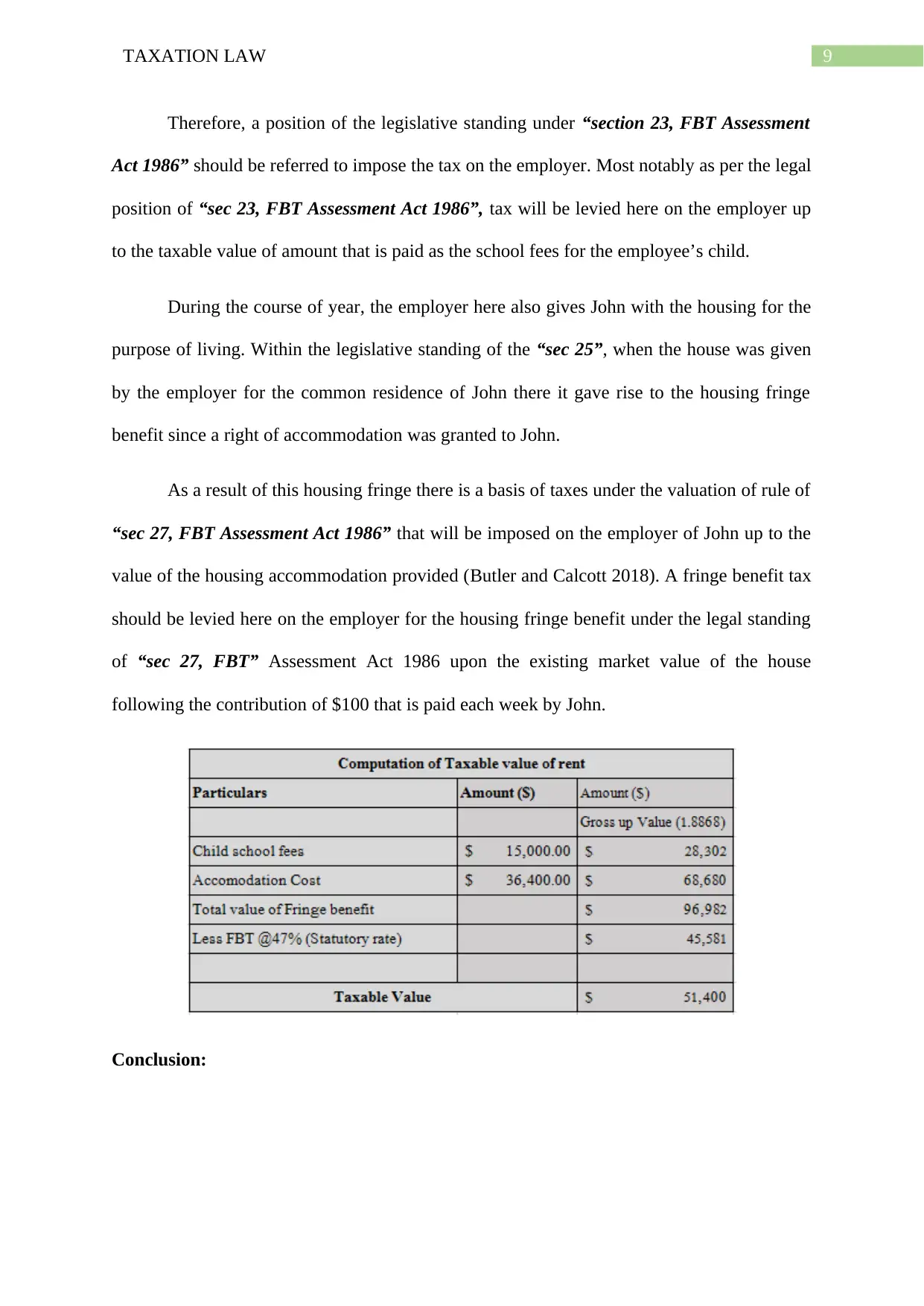
9TAXATION LAW
Therefore, a position of the legislative standing under “section 23, FBT Assessment
Act 1986” should be referred to impose the tax on the employer. Most notably as per the legal
position of “sec 23, FBT Assessment Act 1986”, tax will be levied here on the employer up
to the taxable value of amount that is paid as the school fees for the employee’s child.
During the course of year, the employer here also gives John with the housing for the
purpose of living. Within the legislative standing of the “sec 25”, when the house was given
by the employer for the common residence of John there it gave rise to the housing fringe
benefit since a right of accommodation was granted to John.
As a result of this housing fringe there is a basis of taxes under the valuation of rule of
“sec 27, FBT Assessment Act 1986” that will be imposed on the employer of John up to the
value of the housing accommodation provided (Butler and Calcott 2018). A fringe benefit tax
should be levied here on the employer for the housing fringe benefit under the legal standing
of “sec 27, FBT” Assessment Act 1986 upon the existing market value of the house
following the contribution of $100 that is paid each week by John.
Conclusion:
Therefore, a position of the legislative standing under “section 23, FBT Assessment
Act 1986” should be referred to impose the tax on the employer. Most notably as per the legal
position of “sec 23, FBT Assessment Act 1986”, tax will be levied here on the employer up
to the taxable value of amount that is paid as the school fees for the employee’s child.
During the course of year, the employer here also gives John with the housing for the
purpose of living. Within the legislative standing of the “sec 25”, when the house was given
by the employer for the common residence of John there it gave rise to the housing fringe
benefit since a right of accommodation was granted to John.
As a result of this housing fringe there is a basis of taxes under the valuation of rule of
“sec 27, FBT Assessment Act 1986” that will be imposed on the employer of John up to the
value of the housing accommodation provided (Butler and Calcott 2018). A fringe benefit tax
should be levied here on the employer for the housing fringe benefit under the legal standing
of “sec 27, FBT” Assessment Act 1986 upon the existing market value of the house
following the contribution of $100 that is paid each week by John.
Conclusion:
Paraphrase This Document
Need a fresh take? Get an instant paraphrase of this document with our AI Paraphraser
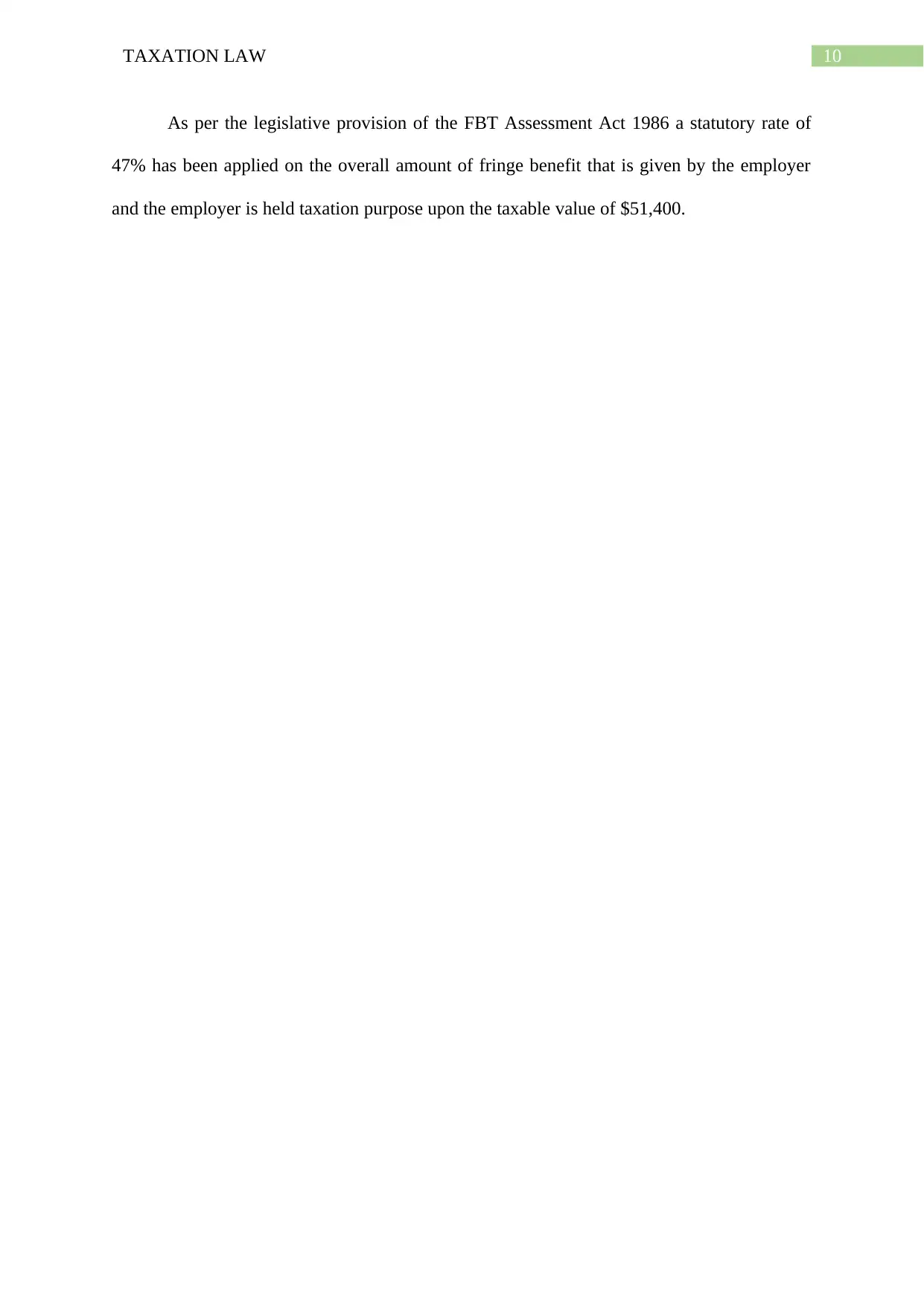
10TAXATION LAW
As per the legislative provision of the FBT Assessment Act 1986 a statutory rate of
47% has been applied on the overall amount of fringe benefit that is given by the employer
and the employer is held taxation purpose upon the taxable value of $51,400.
As per the legislative provision of the FBT Assessment Act 1986 a statutory rate of
47% has been applied on the overall amount of fringe benefit that is given by the employer
and the employer is held taxation purpose upon the taxable value of $51,400.
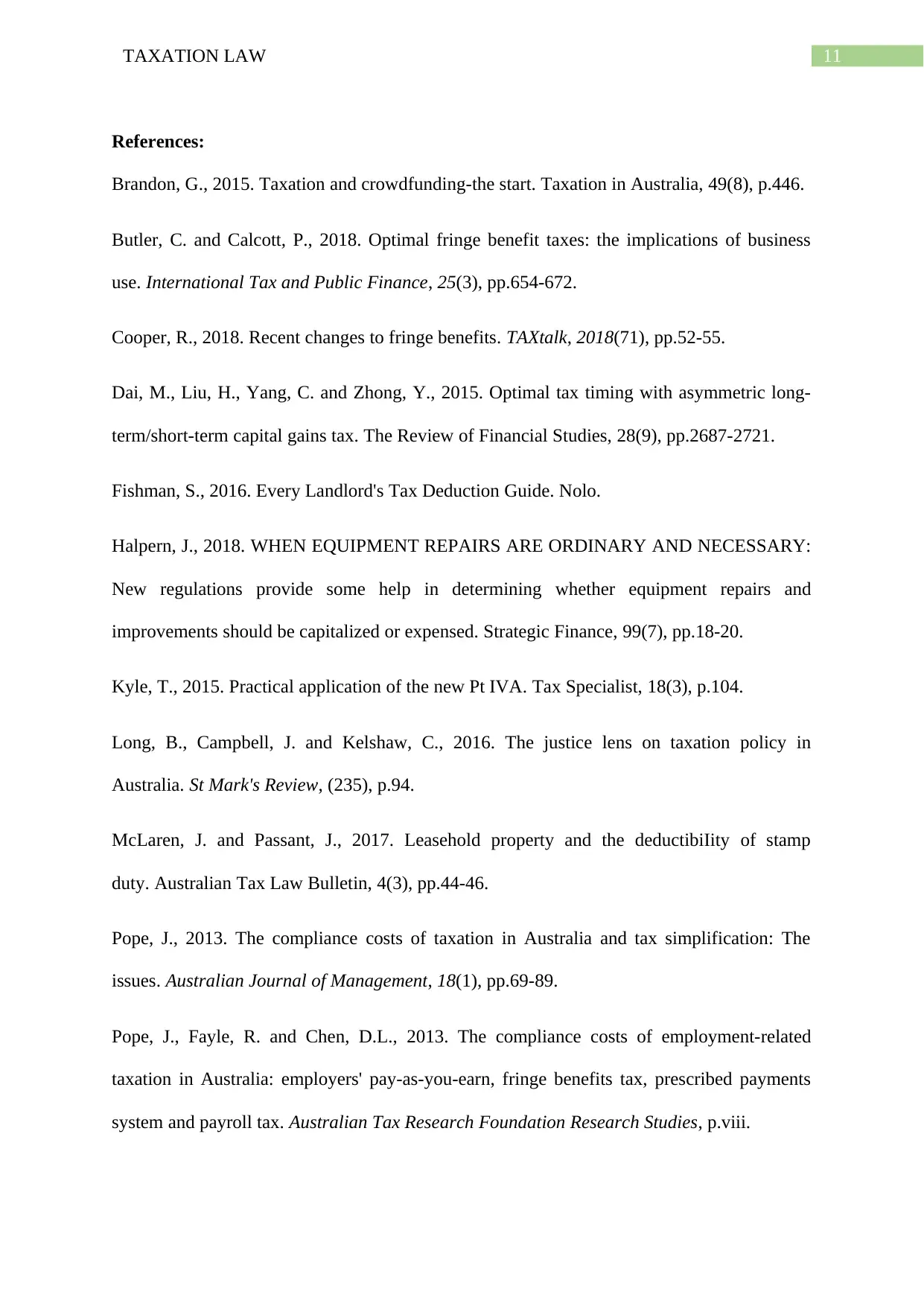
11TAXATION LAW
References:
Brandon, G., 2015. Taxation and crowdfunding-the start. Taxation in Australia, 49(8), p.446.
Butler, C. and Calcott, P., 2018. Optimal fringe benefit taxes: the implications of business
use. International Tax and Public Finance, 25(3), pp.654-672.
Cooper, R., 2018. Recent changes to fringe benefits. TAXtalk, 2018(71), pp.52-55.
Dai, M., Liu, H., Yang, C. and Zhong, Y., 2015. Optimal tax timing with asymmetric long-
term/short-term capital gains tax. The Review of Financial Studies, 28(9), pp.2687-2721.
Fishman, S., 2016. Every Landlord's Tax Deduction Guide. Nolo.
Halpern, J., 2018. WHEN EQUIPMENT REPAIRS ARE ORDINARY AND NECESSARY:
New regulations provide some help in determining whether equipment repairs and
improvements should be capitalized or expensed. Strategic Finance, 99(7), pp.18-20.
Kyle, T., 2015. Practical application of the new Pt IVA. Tax Specialist, 18(3), p.104.
Long, B., Campbell, J. and Kelshaw, C., 2016. The justice lens on taxation policy in
Australia. St Mark's Review, (235), p.94.
McLaren, J. and Passant, J., 2017. Leasehold property and the deductibiIity of stamp
duty. Australian Tax Law Bulletin, 4(3), pp.44-46.
Pope, J., 2013. The compliance costs of taxation in Australia and tax simplification: The
issues. Australian Journal of Management, 18(1), pp.69-89.
Pope, J., Fayle, R. and Chen, D.L., 2013. The compliance costs of employment-related
taxation in Australia: employers' pay-as-you-earn, fringe benefits tax, prescribed payments
system and payroll tax. Australian Tax Research Foundation Research Studies, p.viii.
References:
Brandon, G., 2015. Taxation and crowdfunding-the start. Taxation in Australia, 49(8), p.446.
Butler, C. and Calcott, P., 2018. Optimal fringe benefit taxes: the implications of business
use. International Tax and Public Finance, 25(3), pp.654-672.
Cooper, R., 2018. Recent changes to fringe benefits. TAXtalk, 2018(71), pp.52-55.
Dai, M., Liu, H., Yang, C. and Zhong, Y., 2015. Optimal tax timing with asymmetric long-
term/short-term capital gains tax. The Review of Financial Studies, 28(9), pp.2687-2721.
Fishman, S., 2016. Every Landlord's Tax Deduction Guide. Nolo.
Halpern, J., 2018. WHEN EQUIPMENT REPAIRS ARE ORDINARY AND NECESSARY:
New regulations provide some help in determining whether equipment repairs and
improvements should be capitalized or expensed. Strategic Finance, 99(7), pp.18-20.
Kyle, T., 2015. Practical application of the new Pt IVA. Tax Specialist, 18(3), p.104.
Long, B., Campbell, J. and Kelshaw, C., 2016. The justice lens on taxation policy in
Australia. St Mark's Review, (235), p.94.
McLaren, J. and Passant, J., 2017. Leasehold property and the deductibiIity of stamp
duty. Australian Tax Law Bulletin, 4(3), pp.44-46.
Pope, J., 2013. The compliance costs of taxation in Australia and tax simplification: The
issues. Australian Journal of Management, 18(1), pp.69-89.
Pope, J., Fayle, R. and Chen, D.L., 2013. The compliance costs of employment-related
taxation in Australia: employers' pay-as-you-earn, fringe benefits tax, prescribed payments
system and payroll tax. Australian Tax Research Foundation Research Studies, p.viii.
⊘ This is a preview!⊘
Do you want full access?
Subscribe today to unlock all pages.

Trusted by 1+ million students worldwide
1 out of 13
Related Documents
Your All-in-One AI-Powered Toolkit for Academic Success.
+13062052269
info@desklib.com
Available 24*7 on WhatsApp / Email
![[object Object]](/_next/static/media/star-bottom.7253800d.svg)
Unlock your academic potential
Copyright © 2020–2025 A2Z Services. All Rights Reserved. Developed and managed by ZUCOL.





